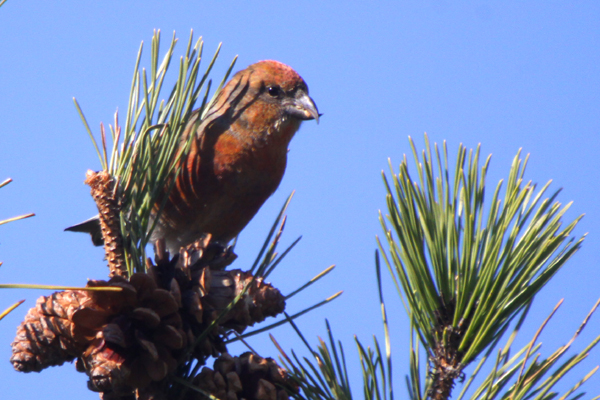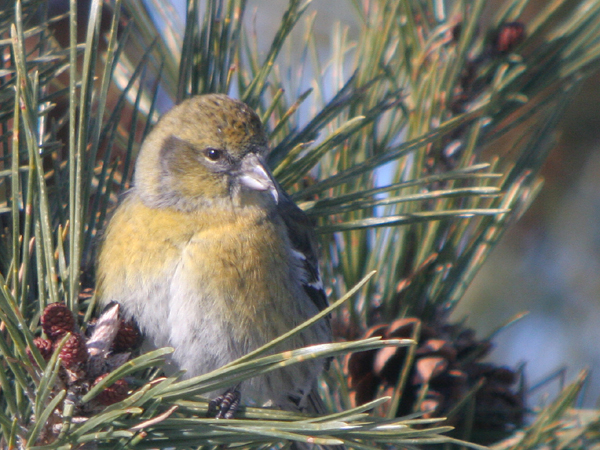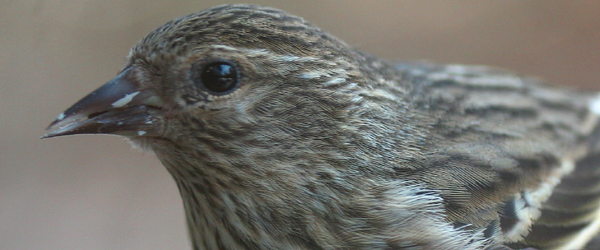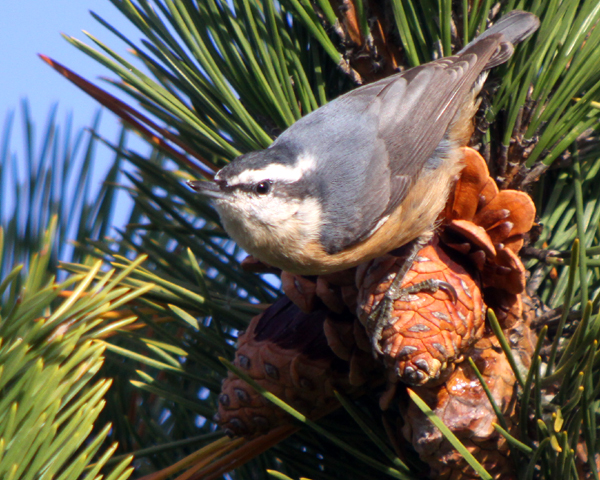Ron Pittaway has published his winter finch forecast for the winter of 2012-2013. Though Ron is based in Ontario his reports are eagerly anticipated by birders across the northeastern United States and eastern Canada because it takes into account a vast array of data to figure out which irruptive species might show up where. It is reproduced in full below, with minor changes to the format and with illustrations added by yours truly.
WINTER FINCH FORECAST 2012-2013
The theme this winter is that each finch species will use a different strategy to deal with the widespread tree seed crop failure in the Northeast. It will be a quiet winter in the eastern North Woods. See individual species forecasts for details. Both coniferous and hardwood tree seed crops are generally poor from northeastern Ontario extending eastward across Quebec to Newfoundland south through the Maritime Provinces, New York and New England States. Within the Northeast there are pockets of good crops. Cone crops are much better in the Hudson Bay Lowlands and northwestern Ontario west to Alberta, Northwest Territories and Yukon. Three irruptive non?finch passerines whose movements are linked to finches are also discussed.
INDIVIDUAL FINCH FORECASTS
PINE GROSBEAK: A good flight is expected into southern Ontario because the mountain?ash berry crop is variable in the boreal forest. Many berries are hard with low moisture content because of the drought. The European mountain-ash and ornamental crabapple crops are poor to fair in southern Ontario so these crops won’t last long. Grosbeaks will be attracted to the usually abundant buckthorn berries and to bird feeders offering black oil sunflower seeds. The Ontario breeding population of this grosbeak is stable.
PURPLE FINCH: Most Purple Finches will migrate south of Ontario this fall because both coniferous and deciduous hardwood seed crops are very low this year in the Northeast. Purple Finch numbers dropped significantly in recent decades as spruce budworm outbreaks subsided and currently a moderate population decline continues in the province.
Red Crossbill
RED CROSSBILL: Red Crossbills comprise at least 10 “types” in North America. Each type probably represents a separate or newly evolving species. Most types are normally impossible to identify in the field without recordings of their flight calls. Matt Young of The Cornell Lab of Ornithology reports that there is currently a large early irruption of Type 3 Red Crossbills (smallest billed type) from the west into eastern North America. Recordings can be made with a cell phone and sent to Matt to be identified (may6 AT cornell.edu). Every recording adds an important piece to the puzzle, especially when accompanied by notes on behaviour and ecology, including tree species used for foraging and nesting. Matt emphasizes that the conservation of call types depends on understanding their complex distributions and ecological requirements.
WHITE-WINGED CROSSBILL: With very poor spruce cone crops in the Northeast, most White-winged Crossbills will likely stay this winter in the Hudson Bay Lowlands, northwestern Ontario and western Canada where spruce cone crops are generally very good. They will be virtually absent from traditional hotspots such as Algonquin Park where spruce crops are very low. Wandering birds may show up throughout the Northeast.
White-winged Crossbill
COMMON REDPOLL: There should be a good southward flight because the white birch seed crop is poor to fair across the north. Watch for redpolls on birches and in weedy fields and at bird feeders offering nyger (preferred) and black oil sunflower seeds. Check flocks for the rare “Greater” Common Redpoll (subspecies rostrata) from the High Arctic. It is reliably identified by its larger size, darker and browner colour, longer/thicker bill and longer tail in direct comparison to “Southern” Common Redpolls (nominate flammea subspecies).
Note: The notion of a “biennial periodicity” that redpolls irrupt south every second winter is not supported by records in Atlantic Canada (Erskine and McManus 2003). The authors concluded that “irregular abundance but near-annual occurrence” of redpolls in the Atlantic Provinces is a better explanation than a two year cycle. Similarly redpolls were recorded on 32 of 38 Christmas Bird Counts in Algonquin Park (Lat. 45.5 N), Ontario.
Common Redpolls
HOARY REDPOLL: Check redpoll flocks for Hoary Redpolls. There are two subspecies. Most Hoaries seen in southern Canada and northern United States are “Southern” Hoary Redpolls (subspecies exilipes). “Hornemann’s” Hoary Redpoll (nominate subspecies hornemanni) from the High Arctic was previously regarded as a great rarity in southern Canada and the northern United States. In recent decades a number have been confirmed by photographs. Hornemann’s is most reliably identified by its larger size in direct comparison to flammea Common Redpoll or exilipes Hoary Redpoll. Caution: White birds loom larger than life among darker birds and size illusions are frequent.
PINE SISKIN: Some siskins currently in the Northeast should move south this fall and winter because cone crops are poor. However, siskins are an opportunistic nomad wandering east and west continent-wide in search of cone crops. Most siskins will probably winter in northwestern Ontario and western Canada where cone crops are generally very good. Major southward irruptions occur when cone crops fail across most of North America.
Pine Siskin
EVENING GROSBEAK: This spectacular grosbeak is ABA’s Bird of the Year in 2012. We can expect some at feeders in central Ontario and probably elsewhere in the Northeast because coniferous and hardwood tree seed supplies are low. Highest breeding densities are found in areas with spruce budworm outbreaks. The larvae are eaten by adults and fed to young. Current populations are much lower than several decades ago when budworm outbreaks were much larger and more widespread.
THREE IRRUPTIVE PASSERINES
Movements of the following three species are often linked to the boreal finches.
BLUE JAY: Expect a smaller flight than last year along the north shorelines of Lakes Ontario and Erie because the red oak acorn crop is very good in central Ontario. Beechnut and hazelnut crops were poor to none, but the acorn crop may be large enough to keep many jays in the north this winter.
RED-BREASTED NUTHATCH: A widespread irruption of this nuthatch beginning in mid-summer indicated a cone crop failure in the Northeast. Most will leave the eastern half of the province for the winter, but some will probably remain in northwestern Ontario where cone crops are much better.
Red-breasted Nuthatch
BOHEMIAN WAXWING: Expect a flight this winter because the mountain-ash berry crop in the boreal forest was affected by drought. Even though some areas have large crops, many berries are hard with low moisture content. Farther south Bohemians will be attracted to the usually abundant buckthorn berries because European mountain?ash and ornamental crabapple crops are generally low and of poor quality.
OTHER INFORMATION
WHERE TO SEE FINCHES: Algonquin Park is a winter adventure about a three hour drive north of Toronto, but this will be a very lean finch winter in the park. Conifer crops are poor to none. Feeders at the Visitor Centre (km 43) should have Pine Grosbeaks, Evening Grosbeaks, and redpolls. The Visitor Centre and restaurant are open weekends in winter. Arrangements can be made to view feeders on weekdays by calling 613-637-2828. The nearby Spruce Bog Trail at km 42.5 and Opeongo Road are good spots for Gray Jays, Boreal Chickadees, Spruce Grouse and Black-backed Woodpeckers. Be sure to get a copy of the new Birds of Algonquin Park (2012) by Ron Tozer. It is one of the best regional bird books ever published with lots of information about winter finches and boreal specialties.
WINTER FINCH BASICS: A primer about finch facts, seed crops and irruptions.
Excellent paper on berry crops in Ontario.
ACKNOWLEDGEMENTS: I thank staff of the Ontario Ministry of Natural Resources designated by an asterisk* and others whose reports allow me to make annual forecasts: Dennis Barry (Durham Region), Eleanor Beagan (Prince Edward Island), Pascal Cote (Tadoussac Bird Observatory, Quebec), Bruce Di Labio (Eastern Ontario and Churchill, Manitoba), Carolle Eady (Dryden), Cameron Eckert (Yukon), Marcel Gahbauer (Alberta & Northwest Territories), Michel Gosselin (Canadian Museum of Nature), David Govatski (New Hampshire), Charity Hendry* (Ontario Tree Seed Facility), Leo Heyens* (Kenora), Tyler Hoar (Northern Ontario & Quebec Laurentians), Jean Iron (Hudson Bay, James Bay & Northeastern Ontario), Bruce Mactavish (Newfoundland), Brian Naylor* (Nipissing), Justin Peter* (Algonquin Park), Genevieve Perreault (Regroupement QuebecOiseaux), Fred Pinto* (North Bay), Harvey & Brenda Schmidt (Creighton, Saskatchewan), Ron Tozer (Algonquin Park), Declan Troy (Alaska), Mike Turner (Haliburton Highlands), John Woodcock (Thunder Cape Bird Observatory) and Kirk Zufelt (Sault Ste Marie, Ontario). I especially thank Matt Young of The Cornell Lab of Ornithology for advice and detailed information about seed crops in New York and adjacent states and for information about Red Crossbills. Jean Iron proofed the forecast and made helpful comments.
LITERATURE CITED: Erskine, A.J. and R. McManus, Jr. 2003. Supposed periodicity of redpoll, Carduelis sp., winter visitations in Atlantic Canada. Canadian Field-Naturalist 117(4):611-620.
Ron Pittaway
Ontario Field Ornithologists
Minden, Ontario
19 September 2012
…


















Beautiful photos! I’m envious, having wanted to see a crossbill for so long. Lots of siskins and nuthatches have crossed my path, and I’m still waiting for a crossbill!
I don’t really care about this report because it says nothing about the western half of the country. They can’t be bothered to do a West Coast version or something? Red-breasted Nuthatches and Red Crossbills are showing up in bigger numbers and in unusual places but we don’t get our own report? Weak.